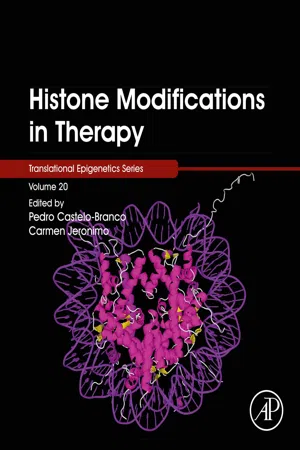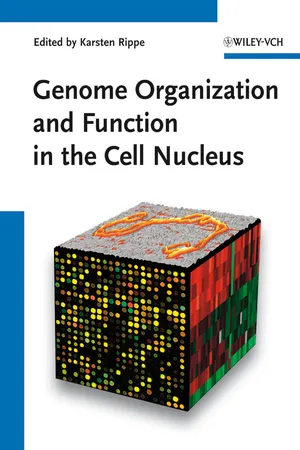Biological Sciences
Chromatin Modification
Chromatin modification refers to the chemical changes that occur to the DNA and associated proteins in the nucleus of a cell. These modifications, such as methylation and acetylation, can alter the structure of chromatin and regulate gene expression. By affecting how tightly the DNA is packaged, chromatin modifications play a crucial role in controlling which genes are turned on or off in a cell.
Written by Perlego with AI-assistance
Related key terms
2 Key excerpts on "Chromatin Modification"
- eBook - ePub
- Pedro Castelo-Branco, Carmen Jeronimo, Pedro Castelo-Branco, Carmen Jeronimo(Authors)
- 2020(Publication Date)
- Academic Press(Publisher)
4Chromatin is the DNA–protein complex found in the eukaryotic cell nucleus, and its primary function is packaging DNA molecules into a more compact, denser shape. The basic repeating unit of chromatin is the nucleosome, which is composed of 146 base pairs of DNA wrapped around an octamer containing two of each core histone H2A, H2B, H3, and H4.5 , 6 DNA is negatively charged due to the phosphate groups in its phosphate-sugar backbone. However, the amino acids lysine and arginine are preponderant in each of the core histones, and their positive charges can effectively neutralize the negatively charged DNA backbone, making the interaction between histones and DNA very tight.5 Nucleosomes are then connected by a linker DNA of varying length, which is further folded into arrays with the aid of the linker histone H1 and nonhistone proteins to form a 30-nm chromatin fiber.6 – 8 This ordered structure enables the necessary compaction to fit the large eukaryotic genomes inside the cell nuclei,9 prevents DNA damage, and regulates DNA replication, cell division, and gene expression.10 , 11Gene expression requires the two strands of DNA to separate temporarily, allowing the access of enzymes involved in transcription to the DNA template. Therefore, although compact, the structure of chromatin must be highly dynamic, switching between an “open” and a “closed” state that regulates the access to the underlying DNA in interphase. Where the chromatin is loosely organized, it is more accessible for transcription and is referred to as euchromatin. However, chromatin can also be highly compacted and inaccessible for transcription in a “closed” or inactive state, the so-called heterochromatin. Therefore genes are coordinately activated or repressed to ensure cellular homeostasis where the chromatin switches between euchromatin and heterochromatin.6 - Karsten Rippe(Author)
- 2012(Publication Date)
- Wiley-VCH(Publisher)
Chapter 4 Histone Modifications and Their Role as Epigenetic Marks Karl Nightingale 4.1 The Complexity of Histone ModificationsThe previous chapter reviewed the nucleosome and how this structure and chromatin together regulate access to the information encoded in the DNA sequence (Chapter 3). It provided ample evidence that the nucleosome is not a static, invariable unit, but is subject to a surprising degree of structural modulation via the incorporation of alternative core histones – a wide range of histone “isoforms” or “variants.” These proteins have regions of sequence divergence, but are often associated with specific areas of the genome, suggesting that the local structure of the chromatin fiber is adjusted to facilitate the functional role(s) of the underlying DNA sequence. This contradicts the textbook impression of chromatin as a uniform, regular, and static “scaffold” for the DNA. In fact chromatin has to be highly dynamic and flexible, reflecting the continuous and rapid changes that characterize nuclear processes in living cells. The post-translational modification of histones plays a central role in regulating these dynamic features of chromatin.Early studies characterizing the composition of chromatin found that the core histones are subject to a wide variety of post-translational modifications (Figure 4.1 ), with the overwhelming majority of these marks found in the N- and C-terminal histone “tails.” These highly conserved, yet apparently unstructured domains protrude from the globular core of the nucleosome and are capable of interacting with many of the components of chromatin. Biochemical characterization has shown that they contribute to the higher-order folding of chromatin, reflecting non-specific electrostatic interactions between the basic (arginine-, lysine-rich) tail peptides and the DNA backbone (Chapter 6). However it is also clear that many functional processes in chromatin are regulated by protein–histone tail interactions that require the specific
Learn about this page
Index pages curate the most relevant extracts from our library of academic textbooks. They’ve been created using an in-house natural language model (NLM), each adding context and meaning to key research topics.

